Click on images to enlarge

infestation (Photo: Forest and Kim Starr, USGS)
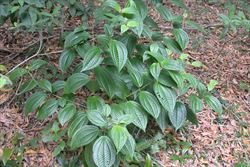
habit (Photo: Simon Brooks)
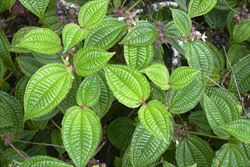
habit (Photo: Forest and Kim Starr, USGS)
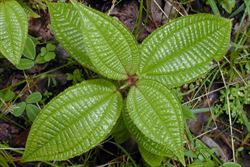
leaves (Photo: Forest and Kim Starr, USGS)
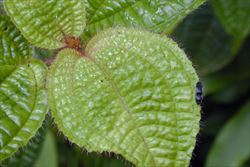
close-up of leaf (Photo: Forest and Kim Starr, USGS)
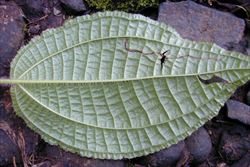
leaf underside (Photo: Forest and Kim Starr, USGS)
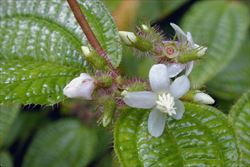
close-up of flowers (Photo: Forest and Kim Starr, USGS)
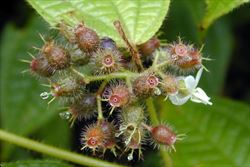
close-up of immature fruit (Photo: Forest and Kim Starr, USGS)
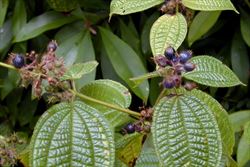
mature fruit (Photo: Forest and Kim Starr, USGS)
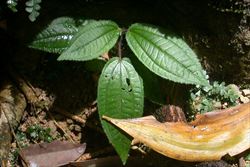
seedling (Photo: Simon Brooks)
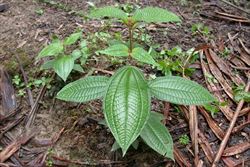
young plant (Photo: Simon Brooks)
Scientific Name
Clidemia hirta (L.) D. Don
Synonyms
Clidemia crenata DC.
Clidemia elegans (Aubl.) D. Don
Melastoma elegans Aubl.
Melastoma hirtum L.
Family
Melastomataceae
Common Names
curse, hairy clidemia, Koster's curse, soap bush, soapbush
Origin
This species is native to tropical America, from southern Mexico south through Central America (i.e. Belize, Costa Rica, Guatemala, Honduras, Nicaragua and Panama) and the Caribbean to parts of South America (i.e. Brazil, Bolivia, Colombia, Ecuador, Peru, Paraguay and northern Argentina).
Cultivation
It has occasionally been cultivated as a garden ornamental.
Naturalised Distribution
Koster's curse (Clidemia hirta) has only recently become naturalised in Australia and is only known from a small area in northern Queensland, near the town of Julatten. It is currently being eradicated.
Also naturalised in tropical Africa, Madagascar, the Mascarenes, the Seychelles, tropical Asia and on several Pacific islands (i.e. in Micronesia, Melanesia, Polynesia and Hawaii).
Habitat
This species prefers humid tropical climates and may invade both disturbed and undisturbed habitats. It is a potential weed of wetter pastures, open grasslands, plantations, roadsides, wetter open woodlands, waterways (i.e. riparian vegetation), forest margins and rainforests.
Habit
A densely branching long-lived (i.e. perennial) shrub normally growing 0.5-3 m tall, but sometimes reaching up to 5 m in height. In more shaded habitats it grows much taller than it does in exposed areas, where it typically grows less than 1 m tall.
Distinguishing Features
- a much-branched shrub with oppositely arranged leaves.
- its stems, leaves and fruit are covered in large, stiff, brownish-coloured hairs.
- its leaves have five prominent veins, finely toothed margins, and a somewhat wrinkled appearance.
- its small white flowers have five petals (6-11 mm long) and distinctive claw-like stamens.
- its small rounded fruit (4-9 mm across) are dark blue, purple or blackish in colour.
Stems and Leaves
The younger stems are rounded and are covered in large, stiff, brown or reddish-coloured hairs (i.e. they are strigose).
The oppositely arranged simple leaves (5-18 cm long and 3-8 cm wide) are borne on stalks (i.e. petioles) 5-30 mm long. They are oval (i.e. elliptic) or egg-shaped in outline (i.e. ovate), with pointed tips (i.e. acute to shortly acuminate apices), and almost entire (i.e. sub-entire) to finely toothed (i.e. crenulate or denticulate) margins. Their upper surfaces are sparsely covered in hairs, similar to those found on the stems (i.e. they are sparsely strigose), while their lower surfaces and margins are more densely hairy. The leaves also have a somewhat wrinkled (i.e. rugose) appearance and five distinct veins that run in an almost parallel fashion from the leaf bases to their tips.
Flowers and Fruit
The flowers are arranged in small clusters in the leaf forks or at the tips of the branches (i.e. in axillary or terminal clusters). Each flower is borne on a very short stalk (i.e. pedicel) 0.5-1 mm long and has five white, or occasionally pale pinkish, petals (6-11 mm long and 4-5 mm wide). The base of the flower is swollen into a cup-shaped structure (i.e. a hypanthium) about 3-3.5 mm long, which is moderately to sparsely covered with a mixture of bristly and sticky (i.e. glandular) hairs. The flowers also have five sepals, but these are very small and inconspicuous (about 0.5 mm long), and five distinctive stamens that have a claw-like appearance. Plants flower and fruit prolifically throughout the year, except during dry periods.
The small, rounded (i.e. globular), fruit (4-9 mm across) are berries and are either dark blue, purplish or blackish in colour. Each of these berries contains over 100 light brown coloured seeds (0.5-0.75 mm long). These fruit are also covered in stiff spreading hairs, especially when they are young.
Reproduction and Dispersal
This plant reproduces by seed, which are principally dispersed by birds that eat the fruit (i.e. frugivorous birds). Other animals moving through thickets of this species may carry seeds away with them (e.g. feral pigs) and the fruit are also dispersed by floodwaters. Long distance dispersal may also be brought about by human activities.
Environmental Impact
Koster's curse (Clidemia hirta) is listed in the Global Invasive Species Database among the top 100 of the world’s worst invasive alien species. Though it currently has a limited distribution in Australia, it is thought to pose a very significant threat to the wetter tropical regions of northern Australia. It is listed as a priority environmental weed in the Far North Queensland Natural Resource Management region and is also on the Northern Australia Quarantine Strategy List.
This species has already caused significant environmental damage in other parts of the world. It is a highly invasive shrub in the montane rainforests and cloud forests of Samoa, Fiji and the Hawaiian Islands. The spread of Koster's curse (Clidemia hirta ) in Hawaii has been linked to soil disturbances, particularly those caused by wild pigs. It is replacing the endemic species that formerly predominated the forests of Hawaii and threatens their extinction. The impact of this weed on native species and ecosystems is devastating and the rate at which it has spread throughout the Hawaiian islands is alarming. It competes with native plants in gaps in undisturbed forests and has the potential to alter forest regeneration.
Koster's curse (Clidemia hirta) is also regarded as one of the most problematic invasive species in the Comoros Archipelago, on La Réunion, in the Seychelles and on Mauritius.
Legislation
This species is declared under legislation in the following states and territories:
- Northern Territory: C - not to be introduced into the Northern Territory.
- Queensland: Class 1 - introduction into the state is prohibited, and landowners must take reasonable steps to keep land free of this species (throughout the entire state). It is also illegal to sell a declared plant or its seed in this state.
- Western Australia: Prohibited - on the prohibited species list and not permitted entry into the state.
Management
For information on the management of this species see the following resources:
- the Biosecurity Queensland Fact Sheet on this species, which is available online at http://www.dpi.qld.gov.au.
Similar Species
This species is quite easily recognisable and there are no native or naturalised species in Australia which closely resemble it. Young plants, with their stiff hairs and crinkled leaves, may vaguely resemble a stinging nettle (Urtica spp.), but mature plants can be distinguished by their shrubby habit and white flowers.

